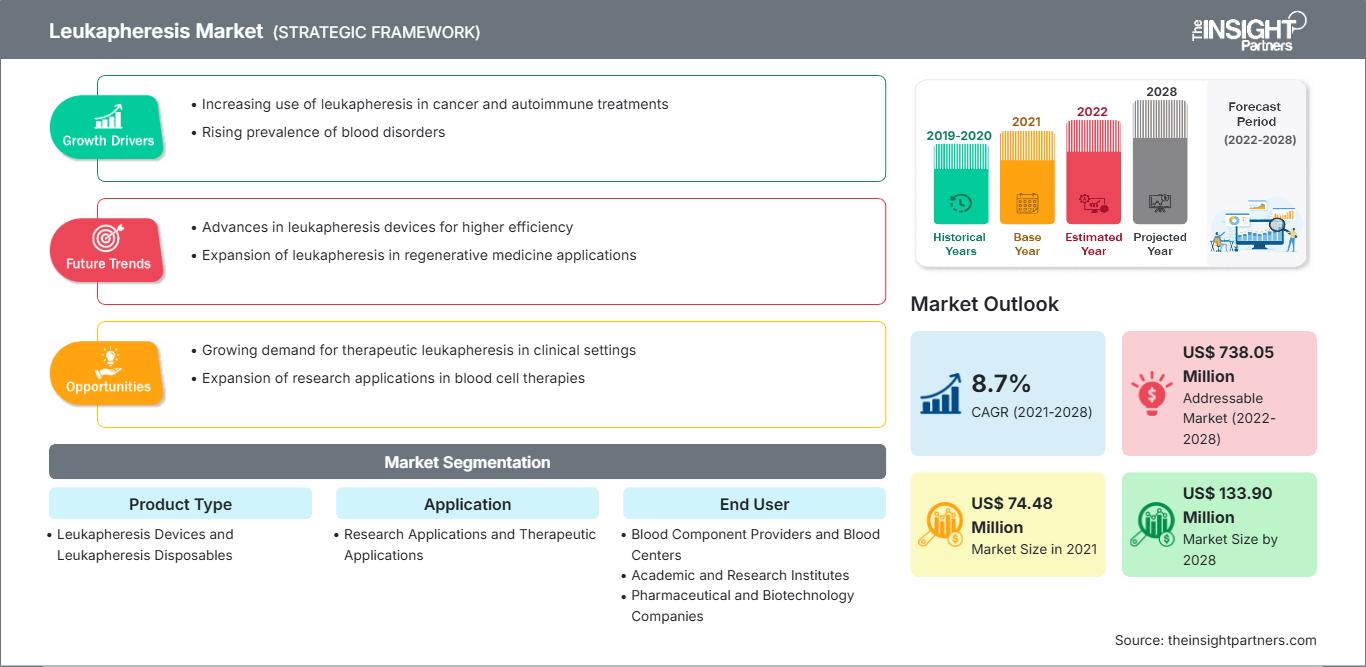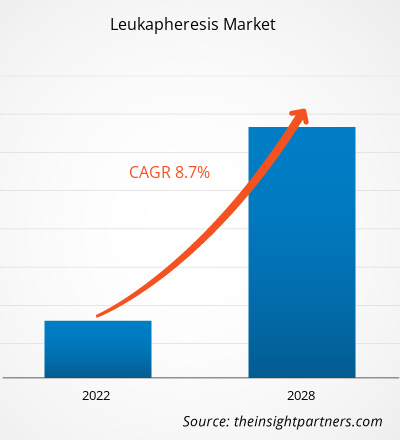[研究报告]白细胞分离术市场规模预计将从 2021 年的 7448 万美元增至 2028 年的 1.339 亿美元;预计 2021 年至 2028 年的复合年增长率为 8.7%。
白细胞分离术是一种将参与人体免疫反应的白细胞从血液样本中分离出来的程序。它是一种特殊形式的血液成分分离术,在提取血液中的一种成分(例如红细胞或血小板)的同时,将剩余的血液重新输送回血液循环。白细胞分离术通常用于降低非常高的白细胞 (WBC) 计数,例如慢性淋巴细胞白血病 (CLL) 等慢性血癌。它也可以用于获取白细胞以供以后移植,例如用于控制癌症化疗期间白细胞计数的急剧下降。另一种用途是作为一种新型免疫疗法的一部分,称为嵌合抗原受体 (CAR) T 细胞疗法,用于帮助对抗白血病、前列腺癌和其他类型的癌症。白细胞分离术可以在申请治疗的患者身上进行(自体单采),也可以在供体进行后续移植(异基因单采)。目前,白细胞分离术常用于治疗各种疾病,也用于诊断目的,因为它可以提高循环肿瘤细胞的产量。自愿献血者人数的增加、血液病发病率的上升以及老龄人口的激增等因素正在推动白细胞分离术市场的增长。然而,白细胞分离术的高成本在一定程度上阻碍了市场的增长。
自定义此报告以满足您的要求
您将免费获得任何报告的定制,包括本报告的部分内容,或国家级分析、Excel 数据包,以及为初创企业和大学提供超值优惠和折扣
白细胞分离术市场: 战略洞察

-
获取本报告的主要市场趋势。这个免费样本将包括数据分析,从市场趋势到估计和预测。
市场洞察
输血是各国国家卫生基础设施和政策不可或缺的一部分。医疗行业的进步带来了严重疾病和伤害治疗程序的改进,最终推动了输血对患者生存的需求。人们越来越意识到输血的重要性以及医疗保健服务中血液供应的充足性,导致愿意为医疗事业献血的人数增加。根据世界卫生组织 (WHO) 的数据,2018 年全球报告的献血量约为 1.174 亿人次。献血者通常分为自愿无偿、有偿和家庭/替代献血者,根据 WHO 的说法,自愿/无偿献血者是可靠和充足血液供应的主要来源。根据 WHO 2019 年的数据,从 2008 年到 2015 年,全球 139 个国家的自愿无偿献血者增加了 1160 万人。在中低收入国家,献血趋势也日益显著。根据2017年CAG年会上公布的数据,2016年约有1,087名患者接受了约13,000次献血。东南亚国家(83%)和美洲(70%)的自愿献血者人数增幅最大。
许多国家制定并推行的国家项目正在进一步吸引大量血小板和血液捐献者。例如,在印度,国家艾滋病控制组织(NACO)下设的国家输血委员会(NBTC)是与州艾滋病控制协会(SACS)下设的州输血委员会(SBTC)进行协调的中央机构。NBTC支持与输血服务(BTS)相关的各种健康项目。因此,全球各国合格捐献者数量的不断增长,推动了对用于分离所需血液成分的白细胞单采设备的需求。
基于产品类型的洞察
根据产品类型,白细胞单采市场分为白细胞单采设备和白细胞单采一次性用品。2021年,白细胞单采一次性用品占据了更大的市场份额。然而,预计在2021年至2028年期间,白细胞单采设备市场的复合年增长率将更高。
基于应用的洞察
按应用,白细胞单采市场分为研究应用和治疗应用。 2021年,研究应用领域占据了更大的市场份额,预计未来几年该领域的复合年增长率将更高。
基于最终用户的洞察
按最终用户划分,白细胞分离术市场可分为制药和生物技术公司、学术和研究机构、血液成分提供商和血液中心以及医院和输血中心。2021年,血液成分提供商和血液中心占据了最大的市场份额。另一方面,预计未来几年医院和输血中心的复合年增长率最高。
在白细胞分离术市场运营的公司正在采用产品发布、并购、合作、产品创新和产品组合扩展等策略,以扩大其全球影响力、维护品牌知名度并满足最终用户日益增长的需求。
白细胞分离术市场区域洞察
The Insight Partners 的分析师已详尽阐述了预测期内影响白细胞分离术市场的区域趋势和因素。本节还讨论了北美、欧洲、亚太地区、中东和非洲以及南美和中美洲的白细胞分离术市场细分和地域分布。
白细胞分离术市场报告范围
| 报告属性 | 细节 |
|---|---|
| 市场规模 2021 | US$ 74.48 Million |
| 市场规模 2028 | US$ 133.90 Million |
| 全球复合年增长率 (2021 - 2028) | 8.7% |
| 历史数据 | 2019-2020 |
| 预测期 | 2022-2028 |
| 涵盖的领域 |
By 产品类型
|
| 覆盖地区和国家 |
北美
|
| 市场领导者和主要公司简介 |
|
白细胞分离术市场参与者密度:了解其对业务动态的影响
白细胞分离术市场正在快速增长,这得益于终端用户需求的不断增长,而这些需求的驱动因素包括消费者偏好的演变、技术进步以及对产品优势的认知度不断提高。随着需求的增长,企业正在扩展产品线,不断创新以满足消费者需求,并抓住新兴趋势,从而进一步推动市场增长。

- 获取 白细胞分离术市场 主要参与者概述
- 白细胞分离术设备
- 分离术设备
- 白细胞分离柱和细胞分离器
- 白细胞减少过滤器
- 白细胞分离术一次性用品
白细胞分离术市场 — 按应用
- 研究应用
- 治疗应用
白细胞分离术市场 — 按最终用户
- 制药和生物技术公司
- 学术和研究机构
- 血液成分提供商和血液中心
- 医院和输血中心
白细胞分离术市场 —按地理
-
北美洲
- 美国
- 加拿大
- 墨西哥
-
欧洲
- 法国
- 德国
- 意大利
- 英国
- 西班牙
- 其他地区欧洲
-
亚太地区(APAC)
- 中国
- 印度
- 韩国
- 日本
- 澳大利亚
- 亚太地区其他地区
-
中东和中东地区非洲(MEA)
- 南非
- 沙特阿拉伯
- 阿联酋
- 中东其他地区和中东地区非洲
-
南美洲 (SAM)
- 巴西
- 阿根廷
- 南美洲和中美洲其他地区
公司简介
- 旭化成株式会社
- Fresenius SE & Co. KGaA
- Haemonetics Corporation
- Terumo Corporation
- STEMCELL Technologies Inc.
- HemaCare
- Macopharma
- AllCells
- STEMEXPRESS
- BioIVT
- 历史分析(2 年)、基准年、预测(7 年)及复合年增长率
- PEST和SWOT分析
- 市场规模、价值/数量 - 全球、区域、国家
- 行业和竞争格局
- Excel 数据集
近期报告
客户评价
购买理由
- 明智的决策
- 了解市场动态
- 竞争分析
- 客户洞察
- 市场预测
- 风险规避
- 战略规划
- 投资论证
- 识别新兴市场
- 优化营销策略
- 提升运营效率
- 顺应监管趋势






















 获取免费样品 - 白细胞分离术市场
获取免费样品 - 白细胞分离术市场